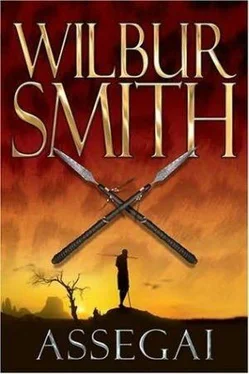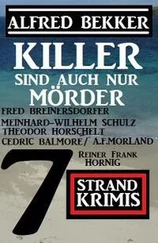Over the weeks that followed, Leon delegated to Max and Hennie most of the petty details, while he spent every hour he could afford in the hangar at the polo field, watching Gustav and his team assemble the two aircraft. Gustav worked with precision and thoroughness. Each of the crates was marked with its contents so they were unpacked in the correct sequence. Slowly, day after day, the jigsaw puzzle of assorted engine parts, rigging wire and struts, wing and fuselage started to take on the recognizable shape of aircraft. When at last Gustav had completed the assembly, Leon was amazed by their size. Their fuselages were sixty-five feet long, and the wing spans a prodigious 110 feet. The framework was covered with canvas that had been treated with a cellulose derivative to give it the strength and tautness of steel. The aircraft were painted in marvellously flamboyant patterns and colours. The first was a dazzling chessboard of brilliant scarlet and black squares and the name painted on its nose was Das Schmetterling – the Butterfly . The second was decorated with black and golden stripes. Graf Otto had christened it Das Hummel – the Bumble Bee .
Once the bodywork had been assembled, the aircraft were ready to receive their engines. There were four 250 horsepower seven-cylinder fourteen-valve rotary Meerbach engines for each. After Gustav had bolted them in turn on to test beds made of teak railway sleepers, he started them. Their roar could be heard miles away in the Muthaiga Country Club, and soon every layabout in Nairobi had arrived to swarm around the hangar, like flies around a dead dog. They seriously impeded the work, and Leon had Hennie erect a barbed-wire fence around the property to keep the gaping throng at a distance.
Once Gustav had tuned the engines, he declared he was ready to fit them to the wings of the two aircraft. One by one they were hoisted by block and tackle on gantries built over the wings. Then he and his mechanics manoeuvred them into position and fixed them into their mountings, two engines on each bank of wings.
Three weeks after the commencement of the work, the assembly of the machines was completed. Gustav told Leon, ‘Now it is necessary to test them.’
‘Are you going to fly them?’ Leon had difficulty containing his excitement, but he was immediately disappointed when Gustav shook his head vehemently.
‘ Nein! I am not a crazy man. Only Graf Otto flies these contraptions.’ He saw Leon’s expression and tried to console him a little. ‘I am only going to ground-taxi them, but you shall ride with me.’
Early the following morning Leon mounted the boarding ladder to the commodious cockpit of the Butterfly . Gustav, in a long black leather coat and matching leather helmet with a pair of goggles pushed up on to his forehead, followed him and seated himself on the pilot’s bench at the rear of the cockpit. First, he showed Leon how to strap himself in. From there Leon watched Gustav’s every move as he waggled the elevators and ailerons with the joystick, then did the same with the rudder bars. When he was satisfied that the controls were free he gave the signal to his assistants on the ground below, and they began the complicated starting routine. Finally all four engines were running smoothly, and Gustav gave the thumbs-up sign to his assistants, who dragged away the wheel chocks.
With Gustav playing the throttles as though they were the stops of a cathedral organ, the Butterfly rolled majestically out of the hangar and into the brilliant African sunshine. A cheer went up from the several hundred spectators who lined the barbed-wire boundary fence. Gustav’s men ran beside the wing-tips to help steer the machine as, bumping and rocking, the Butterfly made four ponderous circuits of the polo ground.
Gustav saw Leon’s yearning and, once again, took pity on him. ‘Come, take the controls!’ he shouted, above the din of the engines. ‘Let’s see if you can drive her.’
Joyfully Leon took his place on the pilot’s bench and Gustav nodded his approval as Leon swiftly gained the feel of joystick and rudder bars, refining his touch on the quadruple throttle levers. ‘ Ja , my engines can feel that you respect and cherish them. You will soon learn to get the very best out of them.’
At last they returned to the hangar, and when Leon had climbed back down the ladder to the ground, he reached up on tiptoe to pat the Butterfly ’s scarlet and black chequered nose. ‘One day I’m going to fly you, my big beauty,’ he whispered, to the towering machine. ‘Damn me if I don’t!’
Gustav came down behind him, and Leon took the opportunity to question him on something that had puzzled him for a while. He pointed out the racks of hooks and braces under the wings on each side of the fuselage. ‘What are these for, Gustav?’
‘They are for the bombs,’ Gustav replied guilelessly.
Leon blinked but kept his manner only mildly curious. ‘Of course,’ he said. ‘How many can she carry?’
‘Many!’ Gustav answered proudly. ‘She is very powerful. Let me give you the English numbers, which maybe you will understand better. She can lift two thousand pounds of bombs, plus a crew of five and her full tanks of fuel. She can fly at a hundred and ten miles per hour at an altitude of nine thousand feet for a distance of five hundred miles and after that return to her base.’
‘She’s amazing!’
Gustav stroked the gaudy fuselage, like a father caressing his firstborn. ‘There is no other machine in the world to match her,’ he boasted.
By noon the following day Penrod Ballantyne had cabled the precise performance figures of the Meerbach Mark III Experimental to the War Office in London.
Leon’s next task was to select four landing strips in the wilderness, one at each of the widely separated locations where he intended to hunt with his client. Graf Otto had cabled him detailed instructions, setting out their required dimensions and their alignment to the prevailing winds. Once he had found suitable locations, Leon shot the levels with a theodolite and pegged out the runways. Meanwhile Hennie du Rand recruited hundreds of men from the surrounding villages and put them to work felling trees and smoothing the ground. In some places he had to dynamite termite mounds, in others to fill in numerous antbear holes and dongas. When each strip was completed he marked the periphery of the runways with lines of burned lime so that they were highly visible from the air. Then he raised one of the windsocks that Gustav had given him. It filled with the breeze and flew proudly at the top of its raw wood mast.
While Hennie built the airfields, Max Rosenthal was responsible for the construction of the elaborate camps that Graf Otto had specified. Leon had to drive both men hard to have everything in readiness for the imminent arrival of their guests. In the end they succeeded, but with only a few days to spare before the ocean liner carrying Graf Otto von Meerbach was due to anchor in Kilindini roads.
Leon bribed his way on board the pilot boat when it went out through the mouth of Kilindini lagoon to meet the German passenger liner SS Admiral from Bremerhaven as she hove up over the horizon. The sea was calm, so it was an easy transfer from the pilot boat to the liner. As he ran up the companion ladder he was challenged by the ship’s fourth officer. When he mentioned his client’s name, the man’s manner changed quickly and he led Leon up to the bridge.
From Kermit’s description, Leon recognized Graf Otto von Meerbach at first glance. He was standing in the wing of the bridge smoking a Cohiba cigar and chatting to the captain, whose attitude towards him was obsequious. Graf Otto was the only passenger allowed on the bridge during the complicated manoeuvre of anchoring the massive liner. Leon studied him for a few minutes, then went up to him to introduce himself.
Читать дальше












